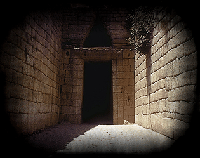About this Museum
About The Hooper Virtual Paleontological Museum
Return to HVPM Lobby
 During the winter 1996 semester I gave students in my Third Year (Junior)
undergraduate Evolutionary Paleoecology class the option of either
writing an essay or preparing a virtual museum display using Hyper
Text Markup Language (HTML). The results were a great success. More
than half of the students in my class of 21 decided to opt for the
HTML project. Their results are presented here as this month's PaleoNet
Forum.
During the winter 1996 semester I gave students in my Third Year (Junior)
undergraduate Evolutionary Paleoecology class the option of either
writing an essay or preparing a virtual museum display using Hyper
Text Markup Language (HTML). The results were a great success. More
than half of the students in my class of 21 decided to opt for the
HTML project. Their results are presented here as this month's PaleoNet
Forum.
The impetus for assigning these projects was the success I had
with similar multimedia computer-based projects a few years ago.
Those projects were compiled using the Apple Macintosh development tool Hypercard and were
based on various paleontological themes presented in lieu of essays. I
still use several of the better Hypercard stacks as supplements to
laboratory exercises. However, the HTML projects are superior to the
old Hypercard projects in a number of ways. First, it is very easy to
create results using HTML. Since HTML is easier to master than
Hypercard programming, students were able to concentrate more on the
material in their display and less on the requirement of learning a
programming language. Secondly because HTML is platform-independent
students could create interchangeable results on whatever computer
happened to be available. This is particularly handy in the computer
lab in our department where there is a hodgepodge of Macintosh,
Windows, and UNIX computers. Finally, students really liked the idea
that they were actually publishing something that potentially
thousands of people might see. This had the advantage that most
students added a little "lagniappe" (a Cajun word meaning a little
something extra) to avoid being embarrassed in front of the Internet
community.
Since the students were publishing their projects, issues like
copyright infringement had to be considered. Some got around this by
only using their own photos, or drawings. Others took advantage of
the numerous images available on the net for free distribution. For
photos that students wanted to use from texts or books I advised them
write letters to the publishers. It seems that many publishers do not
want to bother with student projects such as these, since only one
publisher took the time to reply.
A list of the students who constructed displays along with their
topics are listed below. Based on an informal class poll the best
display was determined to be Mike Wellum's Cobalt Ontario Geology and
Paleontology. However, displays marked by asterisks also received at
least one first place vote. In short, a number of students created
some very good projects.
- Mike Wellum - Geology and Paleontology of Cobalt Ontario
- Bob Boudreau - Geology and Paleontology of the Ottawa Area
- Christian Damus - Evolution of Insect Flight*
- Sean Donaldson - Evolution of Man
- Grant Fowler - Micropaleontology in Seismic Risk Assessment
- Chris Gallagher - Arcellaceans as Paleolimnological Indicators
- Niranjala Kottachchi - The Burgess Shale*
- Martin Novak - Evolution of the Champlain Sea
- Jason Rickard - Micropaleontology in Marine Archaeology
- Kim West - Mass Extinction*
- Scott Whattam - Complexity Theory and Organic Evolution*
Now the disclaimer. The projects you are about visit are
presented "warts and all." Some of the statements may not be entirely
accurate. In addition, as in all student "papers," there are numerous
grammatical errors in some presentations. However, for the most part
I am very pleased with the results. During the summer I will be
heavily editing the best displays. These will become the
core of the "Hooper Virtual Paleontology Museum,² named for now
retired Dr. Ken Hooper, a Carleton University micropaleontologist.
The mandate of the museum will be to provide an on-line
paleontological resource for educators and the general public both in
Canada and abroad.
We hope you enjoy your tour. Please come back
often as there will be new displays added next year.
Return to HVPM Lobby
 During the winter 1996 semester I gave students in my Third Year (Junior)
undergraduate Evolutionary Paleoecology class the option of either
writing an essay or preparing a virtual museum display using Hyper
Text Markup Language (HTML). The results were a great success. More
than half of the students in my class of 21 decided to opt for the
HTML project. Their results are presented here as this month's PaleoNet
Forum.
During the winter 1996 semester I gave students in my Third Year (Junior)
undergraduate Evolutionary Paleoecology class the option of either
writing an essay or preparing a virtual museum display using Hyper
Text Markup Language (HTML). The results were a great success. More
than half of the students in my class of 21 decided to opt for the
HTML project. Their results are presented here as this month's PaleoNet
Forum.